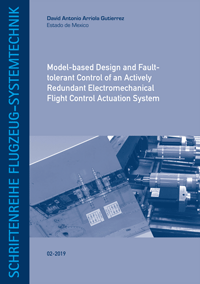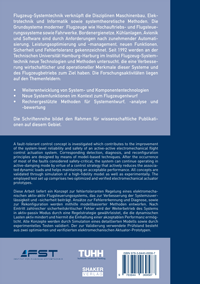
Shop : Details
Shop
Details
49,80 €ISBN 978-3-8440-6958-7Softcover248 pages14 figures371 g21 x 14,8 cmEnglishThesis
October 2019
David Antonio Arriola Gutierrez
Model-based Design and Fault-tolerant Control of an Actively Redundant Electromechanical Flight Control Actuation System
As of today, the largest efforts to enable the introduction of EMAs in primary flight controls have focused on the reduction of the actuator components’ weight as well as on the improvement of their reliability at the required performance. These steps are certainly fundamental and have led to attaining a higher maturity level at which the deployment of EMAs in the front-line seems feasible. Still, very few has been done with regard to the fault management in electromechanical active-active actuation systems. A fault-tolerant control concept is thus herein developed with the objective of making such systems comparable to the state-of-the-art in terms of safety, reliability, and availability.
An ample set of design recommendations and findings with respect to the application of electromechanical actuators in primary flight controls emerge from the design tasks carried out along this thesis. Furthermore, a number of model-based notions are established as design-support means; their aptness is demonstrated through experimental verification and validation. A special emphasis is made on the optimal design of the electromechanical actuators utilized throughout the development of the fault-tolerant control concept. The goal is to put forth a concept that is representative of real aerospace applications. Furthermore, all the adopted actuator control approaches attempt to observe the general goals of satisfactory performance and low complexity. Little regard is paid to the areas of power electronics design and thermal actuator sizing as these are not decisive aspects for the proof of concept—corresponding assumptions are given.
An ample set of design recommendations and findings with respect to the application of electromechanical actuators in primary flight controls emerge from the design tasks carried out along this thesis. Furthermore, a number of model-based notions are established as design-support means; their aptness is demonstrated through experimental verification and validation. A special emphasis is made on the optimal design of the electromechanical actuators utilized throughout the development of the fault-tolerant control concept. The goal is to put forth a concept that is representative of real aerospace applications. Furthermore, all the adopted actuator control approaches attempt to observe the general goals of satisfactory performance and low complexity. Little regard is paid to the areas of power electronics design and thermal actuator sizing as these are not decisive aspects for the proof of concept—corresponding assumptions are given.
Keywords: Flight control systems; electromechanical actuation; active redundancy; model-based design; model-based optimization; fault-tolerant control; fault detection; fault diagnosis
Available online documents for this title
You need Adobe Reader, to view these files. Here you will find a little help and information for downloading the PDF files.
Please note that the online documents cannot be printed or edited.
Please also see further information at: Help and Information.
Please also see further information at: Help and Information.
| Document |  | Document | ||
| Type |  | |||
| Costs |  | 37,35 € | ||
| Action |  | Purchase in obligation and download the file | ||
| Document |  | Table of contents | ||
| Type |  | |||
| Costs |  | free | ||
| Action |  | Download the file | ||
User settings for registered online customers (online documents)
You can change your address details here and access documents you have already ordered.
User
Not logged in
Export of bibliographic data
Shaker Verlag GmbH
Am Langen Graben 15a
52353 Düren
Germany
Am Langen Graben 15a
52353 Düren
Germany
Mon. - Thurs. 8:00 a.m. to 4:00 p.m.
Fri. 8:00 a.m. to 3:00 p.m.
Fri. 8:00 a.m. to 3:00 p.m.
Contact us. We will be happy to help you.



